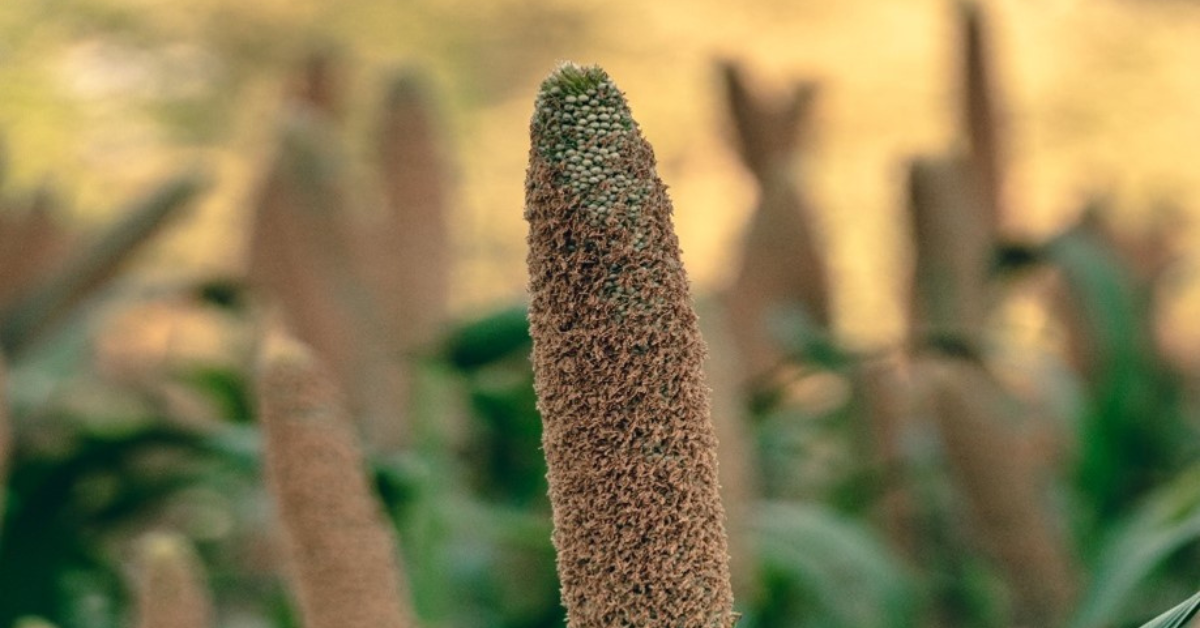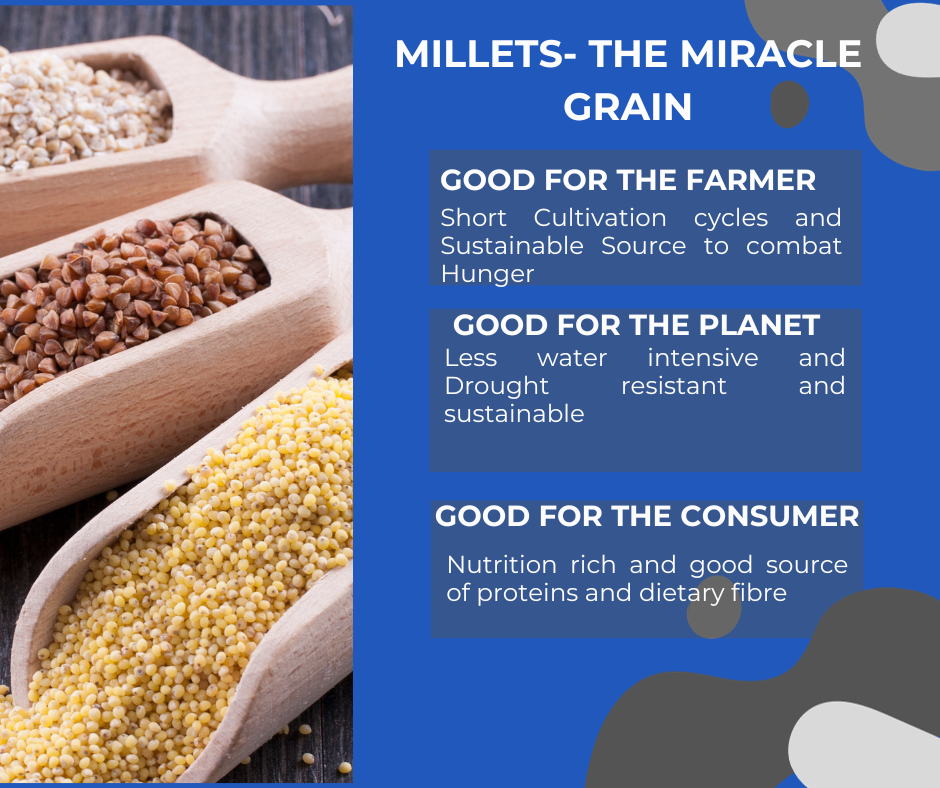Contact: +91 99725 24322 |
Menu
Menu
Quick summary: Explore the eco-friendly realm of millets and their positive impact on the environment. Discover how these grains promote sustainable agriculture, requiring less water and pesticides, and contribute to reducing the carbon footprint. Uncover the significance of traceability in millet cultivation for a more transparent and environmentally conscious food system.

Millets small, yet mighty, grains have been integral to human diets for centuries, offering not only a rich source of nutrition but also presenting a sustainable alternative for agriculture. Millets stand as environmentally friendly grains, demanding minimal water and pesticides for cultivation. Elevating millet production and consumption emerges as a compelling avenue to champion sustainable agriculture, significantly diminishing the carbon footprint on our planet.
Millets are drought resistant, requiring a very low amount of water; approximately 200-300 litres of water is required to produce 1 kg of millet
In this blog, we delve into the environmental significance of millets, exploring how their cultivation and consumption can contribute to biodiversity conservation, climate resilience, and a more sustainable and resilient food system. Join us on a journey to discover the environmental benefits of embracing millets as a key player in the quest for a healthier planet.
Millets are a group of small-seeded grasses cultivated for human consumption. Nutrient-rich and resilient, they include varieties like sorghum and pearl millet. These grains are gluten-free, environmentally sustainable, and contribute to food security, making them crucial for diverse, nutritious diets worldwide.
Millets hold historical significance as ancient grains cultivated across various civilizations. Their cultural importance is reflected in traditional cuisines, rituals, and folklore. Adaptability to diverse climates contributed to their global presence, sustaining communities and shaping culinary heritage, showcasing the rich interplay between agriculture, culture, and history.
Millets are gaining recognition in modern diets due to their nutritional density, gluten-free nature, and environmental sustainability. As awareness of health and ecological concerns rises, these ancient grains are increasingly incorporated into contemporary meals, appealing to those seeking diverse, nutrient-packed alternatives in their quest for balanced and sustainable nutrition.

Millets serve as staple crops in many regions, providing a primary source of nutrition for diverse communities. Their versatility in culinary applications, combined with resilience to harsh conditions, makes them dependable staples. As climate-smart alternatives, millets offer sustainable food security, showcasing their importance in maintaining dietary traditions and ensuring reliable agricultural yields in the face of environmental challenges. Millets encourage sustainable farming practices by thriving in diverse climates with minimal chemical inputs. Their efficient water usage and resilience reduce the environmental impact of agriculture. Crop rotation with millets enhances soil fertility and reduces the need for synthetic fertilizers. Embracing millets promotes eco-friendly, resource-efficient farming, aligning with the principles of sustainable agriculture for a resilient and environmentally conscious food production system.
Millets contribute to soil health through crop rotation, a sustainable farming practice. Their deep root systems help prevent soil erosion and enhance soil structure. As nitrogen-fixing crops, they enrich the soil with essential nutrients, reducing the reliance on synthetic fertilizers. Integrating millets into crop rotations promotes long-term agricultural sustainability by maintaining soil fertility and minimizing environmental impact.
Millets have a low water footprint, requiring significantly less water compared to traditional grains like rice. Their efficient water usage, coupled with resilience to arid conditions, makes millets an environmentally friendly choice in regions facing water scarcity. Cultivating millets aligns with sustainable water management, addressing concerns about water availability in agriculture. Millets showcase exceptional drought resistance and adaptability, thriving in water-scarce regions. Their hardy nature enables cultivation in challenging climates, contributing to food security amid water shortages. As climate change intensifies, the adaptability of millets becomes increasingly valuable in ensuring stable agricultural yields and sustaining communities facing unpredictable environmental conditions.
Millets are ideal for water-scarce regions, flourishing with minimal water requirements. Their drought tolerance and efficient water use make them a resilient crop choice, supporting agriculture in areas facing water scarcity. By reducing dependence on water-intensive crops, millets offer a sustainable solution for cultivating nutritious grains in regions with limited water resources.
Millets contribute to the preservation of native varieties by maintaining diverse, locally adapted strains. These unique genetic traits enhance resilience to pests and diseases. Cultivating a range of millet varieties supports biodiversity, ensuring the conservation of traditional crops and fostering agricultural sustainability rooted in the rich genetic heritage of each region. Millets play a pivotal role in promoting agroecological diversity by thriving in varied climates and soils. Their cultivation encourages the integration of diverse crops, fostering a balanced ecosystem. The inherent adaptability of millets contributes to resilient agroecosystems, reducing reliance on monoculture and promoting sustainable farming practices for long-term environmental and agricultural health.
Millet cultivation supports pollinators and overall ecosystem health. As flowering plants, millets attract bees and other pollinating insects, enhancing biodiversity. This mutually beneficial relationship contributes to the health of surrounding ecosystems, highlighting the role of millets not only in agriculture but also in fostering a sustainable balance within natural environments.
Millets play a crucial role in global food security by offering a resilient, nutritious, and climate-smart crop option. Their adaptability to diverse environments provides a reliable source of food, especially in regions susceptible to climate change impacts. The nutritional density of millets contributes to a more sustainable and secure global food supply.
Millets exhibit resilience to changing climate conditions, thriving in diverse climates with erratic rainfall and temperature variations. Their adaptability makes them a valuable asset in agriculture, ensuring stable yields despite unpredictable weather patterns. As climate change intensifies, the resilience of millets becomes increasingly significant for sustainable food production.
Millets stand out as a smart crop choice due to their versatility, low water footprint, and adaptability to diverse climates. With resilience to changing environmental conditions, they offer a sustainable solution for food security. Embracing millets aligns with smart agriculture practices, addressing challenges posed by climate change and promoting long-term agricultural sustainability.
Millets face challenges such as limited awareness, market access, and policy support, hindering their widespread adoption. However, opportunities abound. Millets’ nutritional benefits align with health-conscious consumer trends, presenting a market potential. Sustainable agriculture initiatives and climate-resilient farming emphasize millets as a key player. Collaboration between farmers, governments, and industries can address challenges and unlock the economic potential of millets. Research and development, coupled with educational campaigns, can elevate awareness and foster appreciation. Embracing millets not only addresses food security and health but also contributes to sustainable agriculture, making them a promising component of future food systems.
Traceability in millet cultivation is not only a tool for improving agricultural practices but also a means of meeting the growing demands for safe, sustainable, and high-quality food products.
Traceability ensures that the millets produced meet specific quality standards. It allows farmers and producers to identify and address any issues in the cultivation process that might affect the quality of the final product.
Traceability provides transparency across the millet supply chain. From farm to table, consumers, retailers, and other stakeholders can track the journey of millets, fostering accountability and trust in the supply chain.
Traceability provides consumers with information about the origin and production practices of the millets they consume. This transparency builds consumer confidence, especially among those who prioritize sustainability, ethical farming, and product safety.
Global trends in millet consumption are on the rise, fueled by growing awareness of their nutritional benefits and climate-smart attributes. Millets are gaining popularity as gluten-free, sustainable alternatives, reflecting a shift towards diverse and health-conscious diets.
Ongoing research and innovations in millet agriculture focus on enhancing yield, resilience, and nutritional content. Breeding programs and technological advancements aim to optimize cultivation practices, addressing challenges and further establishing millets as a resilient and productive crop.
Millets are positioned as a sustainable food trend, aligning with global efforts towards eco-friendly and nutritious eating. As consumers increasingly prioritize health and environmental impact, the versatility and sustainability of millets position them as a staple in future food trends.
In conclusion, millets emerge as key contributors to sustainable agriculture, addressing global challenges such as climate change and food security. Their adaptability, nutritional richness, and low environmental impact make them a smart choice for resilient farming and diverse, health-conscious diets. As awareness grows, coupled with ongoing research, millets are poised to play an increasingly significant role in shaping the future of sustainable food systems, supporting both the well-being of individuals and the health of our planet. Embracing millets reflects a proactive step towards a more sustainable, nutritious, and resilient global food landscape.
